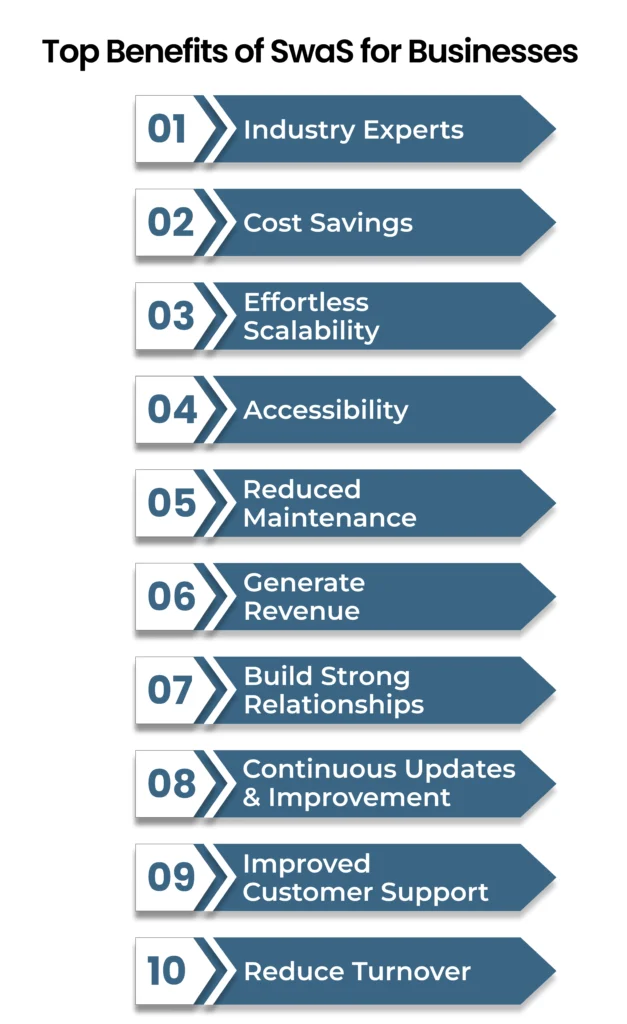
Software with a service or SwaS for short, can help businesses to stay ahead in today’s digital marketplace. It is currently one of the best-known branches of cloud computing.
Several companies have started to shift towards this business model because it offers a more personalized experience. Smaller businesses can adopt this technology because they don’t need to invest as much time or money.
Moreover, this model allows the customer to focus on their core business activities while the vendor handles the technical aspects of the software. It can provide a more comprehensive and integrated solution compared to a pure software licensing or SaaS model.
Businesses need to understand the various benefits of SwaS model provides. It helps to make an informed decision before implementing it organization-wide.
So, in this blog, we have listed the pros of SwaS development for your business operations with some other information.
What is Software with a Service?
SwaS is a software delivery model that combines traditional software with a service component. In a SwaS model, the software vendor provides the software application and offers additional services and support to the customer. This can include things like:
Consulting and Implementation Services
- Helping the customer plan, configure, and deploy the software.
- Providing training and change management support.
Ongoing maintenance and support
- Regularly updating and upgrading the software.
- Providing technical support and troubleshooting.
Managed services
- Taking over the day-to-day administration and management of the software.
- Monitoring system performance and handling backups, security, and compliance.
Value-added services
- Offering complementary services that enhance the software’s functionality.
- Providing analytics, reporting, or business process optimization services.
Furthermore, SwaS is commonly seen in enterprise software, industry-specific applications, and complex software systems that require a high level of customization and support.
Top Benefits of SwaS for Businesses
Software with a service is becoming more and more popular due to the several benefits it provides to small and medium-sized businesses.
So, let’s explore the benefits that businesses get from SwaS.

1. Industry Experts
One of the key benefits of SwaS is access to industry experts who can help reduce the workload for the business. With the SwaS model, businesses don’t have to hire and manage their in-house IT staff with specialized expertise. Instead, they can tap into the deep bench of industry experts employed by the SaaS provider. These experts are responsible for tasks like:
- Developing and updating the software
- Managing the technology infrastructure
- Providing technical support
- Regulatory compliance and data protection
By using the SwaS provider’s experts, the business can focus on its core operations. They don’t have to build and maintain a big internal IT department. The SwaS experts take care of the technical work.
Additionally, SwaS providers are typically much more up-to-date on the latest industry trends, best practices, and technology innovations. This expertise can be invaluable for businesses looking to stay competitive.
2. Cost Savings
It is another main benefit that businesses get from the SwaS model. Businesses don’t need to invest in the expense of buying and maintaining software and IT infrastructure. This eliminates the capital expenditures associated with on-premise software deployments.
3. Effortless Scalability
SwaS apps can help businesses to meet their changing demands. When the business grows and you need to add new users, no need to buy server space and additional software licenses for new users. All you have to do is upgrade the subscription for the SwaS application or your existing plan to accommodate the new users. This helps you to cut down on subscription costs.
Moreover, the subscription-based SwaS model allows businesses to scale up or down their software usage as needed. They can quickly add or remove users, features, and storage capacity without major capital outlays. This makes SwaS well-suited for businesses with variable or growing needs.
4. Accessibility
With an internet connection, SwaS can be accessed from anywhere. The software itself is hosted in the cloud, rather than being installed locally, allowing users to access it over the internet. The additional services provided by the vendor, such as support, updates, and maintenance, are also delivered remotely through the internet connection.
5. Reduced Maintenance
The software, servers, and other infrastructure must be maintained by the SwaS provider. This reduces the involvement of an organization’s own IT staff. Also, it allows the organization’s internal resources to focus on their core business activities rather than software and infrastructure maintenance.
6. Generate New and Existing Revenue
SwaS helps businesses generate new revenue. When businesses provide personalized, value-added services on top of the core software, businesses can differentiate themselves from competitors who may only provide the standard software functionality. This helps businesses stand out in crowded markets and attract new customers who are seeking a more customized, high-touch experience.
Furthermore, providing ongoing support, consulting, training, or premium features helps businesses to grow existing revenue. It helps businesses to boost profitability.
7. Build Strong Customer Relationships
It helps businesses build strong customer relationships and increase retention rates is a significant advantage over the traditional SaaS model. SwaS customers are less likely to churn compared to traditional SaaS customers.
8. Continuous Updates and Improvement
According to customer feedback and changing market needs, businesses can improve their offerings with SwaS. With ongoing support, regular software updates, monitoring, and optimization allow businesses to benefit from the advanced features. This approach helps businesses maintain long-term customer satisfaction and stay ahead of the competition.
9. Improved Customer Support
The comprehensive customer support enabled by the SwaS model can significantly enhance customer satisfaction and loyalty. When customers feel truly supported and valued throughout their journey, they are more likely to continue using the software, expand their usage, and recommend the business to others.
10. Reduce Turnover
The SwaS model can help businesses reduce churn, increase customer retention, and drive higher revenue. Providing ongoing support and responsiveness helps address customer pain points and reduces the likelihood of churn. Customers are less likely to become detractors when they feel their needs are being consistently met through the complete SwaS solution.
Difference between SaaS and SwaS
The below table shows the differences between SaaS and SwaS.
| Aspect | SaaS | SwaS |
| Ownership Model | Software is owned and managed by the SaaS provider | Software is owned by the SwaS provider, but the service components are co-owned and co-managed with the customer |
| Delivery Model | Software is delivered entirely through the cloud/internet | Software is delivered through the cloud but with additional on-site or hybrid service components |
| Customization | Limited customization options, with a focus on standardized features | Greater customization and tailoring of the software and service elements to meet specific customer needs |
| Customer Support | Standardized support, often through online resources and limited direct interaction | Comprehensive, personalized customer support, including onboarding, training, technical assistance, and ongoing consultancy |
| Pricing Model | Subscription-based pricing, often tiered based on usage or features | Combination of software licensing, service fees, and potentially usage-based pricing |
| Relationship with Customer | Transactional, with a focus on self-service and automation | Collaborative, with a focus on partnership and ongoing engagement |
| Flexibility and Responsiveness | Limited ability to rapidly adapt to changing customer needs | Increased flexibility and responsiveness to incorporate customer feedback and changing requirements |
| Revenue Model | Recurring revenue from software subscriptions | Recurring revenue from software licenses and service fees, the potential for higher margins |
Conclusion
SwaS is gaining significant popularity. It is the best alternative to traditional software models that help you reduce costs and increase the productivity of your business.
Now, you know the benefits of SwaS, Therefore, start implementing it, generate revenue, gain more customers, and stand out in a crowded marketplace.
So, if you want to transform your business operations and gain a competitive advantage, schedule a meeting with us. We have a team of experts to help you develop SwaS applications according to your business needs.







